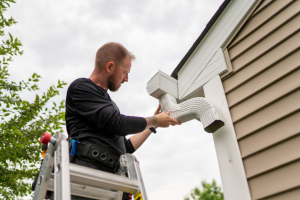Gutters play an often overlooked, yet essential role on any property when it comes to capturing water runoff from the roof and properly dispersing it away from a foundation. When gutters are installed correctly and work as they should, they can help reduce the risk of water intrusion, water damage and foundation degradation. And while gutters may seem like a simple exterior home component, there’s a lot involved in installing a system properly.
In this post, we’ll discuss some of the common parts and accessories involved in a gutter installation as well as some of the tools necessary to get the job done correctly. Here’s a look at what you need to know:

Common Parts and Accessories in A Gutter Installation
Let’s start by discussing some of the parts included in the gutter installation. As you might imagine, there’s more involved than just the gutters and the downspouts (not to say that those components aren’t important). In this section, we’ll cover the parts and accessories that you need or may need in a new installation:
Gutters
Gutters are parts that run horizontally along the roofline and work to capture snow melt and rain water runoff. Gutters should be installed so that they gradually slope toward the downspouts (more on those next). In fact, it’s best practice to install gutters angled at a quarter-inch of slope for every 10 feet. Gutters come in 4, 5 and 6-inch sizes, and in special cases, 7-inch sizes are available.
Downspouts
Gutters should be installed to slope toward downspouts. Downspouts are installed vertically and, as their name implies, take water from the gutters and discharge it away from the property. Poorly installed downspouts are more likely to lead to water pooling around the foundation, which can lead to foundation erosion and potential water intrusion and damage. Downspouts should discharge water 4 to 6 feet away from the foundation. For best results, the land grading should slope away from the home. In some cases, downspout extenders may need to be installed at the ends of downspouts to ensure that water is draining far enough away from the property.
Elbow Joints
Elbow joints are a part of the downspout. They’re angled pieces that allow the gutter system to better travel around the bends of a home. It’s important to make sure that there’s a good seal where end joints connect with the downspouts, as they’re one of the more problematic parts of the gutter system that tend to clog with debris often.
End Caps
End caps are pieces that attach to the open ends of gutters, typically where the gutters extend past the downspouts. Without end caps, water that’s collected in the gutters could flow out and collect around your home, thereby somewhat defeating the purpose of the gutter system.
Fascia Boards
Fascia boards run under the roofline and are the material that gutters are typically installed on. In many cases, new gutter installations are able to be performed over existing fascia boards. However, in some cases, there may be damage to these boards, thereby requiring replacement prior to gutter installation. Replacement may also be necessary for aesthetic purposes if gutter installation is part of a larger overall exterior home project.
Gutter Hangers
Gutter hangers essentially ensure that the gutter stays attached to your roof and/or the fascia board. They help the gutter system stay secure and stable, which is necessary during storms when heavy rain can enter and weigh down the system. Gutter hangers should be installed about every 36 inches to properly secure the system.
Gutter Guards
Finally, an add-on option that you may elect to have installed when getting new gutters are gutter guards. These pieces fit over the gutters, and block twigs, leaves and other debris from entering the gutter system, while allowing water to pass through and drain appropriately. Gutter guards are especially helpful in areas with dense foliage or for property owners who either don’t like cleaning their gutters or don’t like paying someone to do it for them. They can help eliminate clogs in the system and ensure that your gutters are always getting the job done.
Tools and Accessories Needed to Perform a Gutter Installation
Aside from the major components, there are a lot of tools and accessories needed for a gutter installation as well. In this section, we’ll take a look at some of the gear that you want to be sure to have in your toolbox.
- Tin snips: After you measure the gutters, a pair of tin snips is usually sufficient to make the cuts you need to make so the gutters fit properly on the home.
- A ladder: Even on a one-story home, if you’re planning to safely install gutters along the roofline, you’re going to need a ladder to properly access the space and install the gutter components.
- A rivet gun and rivets: These help connect the various gutter components (gutters, end caps, elbows, downspouts) together to form the home’s gutter system.
- Caulk: It’s always good practice to caulk gutter seams to guard against unwanted leaks in the system.
- Other tools and parts: A cordless drill, a hex head driver, measuring tape and gutter fascia are also good to have on hand.
Contact K-Guard Today
For more information on what’s involved in a typical gutter installation and to learn more about the importance of gutters and gutter guards, contact K-Guard today or contact your local K-Guard distributor.
This post first appeared on https://www.kguard.com